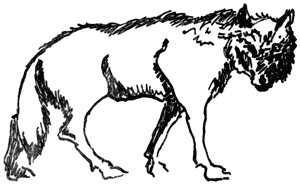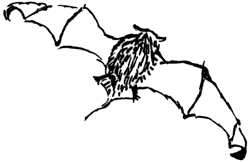Deer Observations
By O. L. Wallis, Ranger-Naturalist
Although three species of deer are reported from the park area, the occasion is noteworthy that specimens of each form are seen within the course of one day’s travel within the park. On July 27, while driving down the Wineglass motorway with Ranger-Naturalist Don Findlay, I observed and Idaho whitetail doe, Odocoileus virginianus ochrourus Bailey, cross the road and dash off into the timber with its “flag” highly raised.
Later in the morning three Rocky Mountain mule deer bucks Odocoileus hemionus hemionus (Rafinesque), were seen by the roadway near Bear Creek. Their white rump patches and black-tipped creamy tails showed distinctly against the dark background of the lodgepole timberland. This sector of the park is typical of the preferred arid habitat of this species.
On the way back to the Park Headquarters, three Columbia blacktail deer, Odocoileus hemionus columbianus (Richardson), were feeding in the meadow between Kerr Notch and Lost Creek Ranger Station.
Members of the guided trip afield had opportunity to observe a mule deer buck near the summit of Garfield Peak on August 4. This buck had one of its antlers broken and the other was still in the velvet. The tail, although typically cylindrical in shape and creamy in color, had a black strip extending down its entire length; the white rump patch was greatly reduced. These characteristics would seem to indicate that this individual was an intergrade with the Columbia blacktail deer.
While conducting a stream survey on upper Bybee Creek, I observed a large six point whitetail buck along the stream, one mile below Lightning Spring.
Blacktail were seen on various occasions along the streams and the highway in the western portions of the park through the summer. These, the most abundant of park deer, appear to be present in their usual numbers. There was a good fawn crop, so numerous fawns were to be seen during the season.
Bat Recorded from Wizard Island
By O. L. Wallis, Ranger-Naturalist
A small bat was observed dipping down to take a drink from the waters of Emerald Pool on the west side of Wizard Island at midday on August 23. Later it was seen zigzagging after flying insects. On August 17, this bat presumably was also observed in the early afternoon resting on one of the angular pieces of lava in the bright sunlight.
Later the specimen was collected for identification. It was a small bat with brownish body and black wings, and probably belongs to the genus Myotis although positive identification will be made by a specialist in the near future.
This is the first known record of a bat on Wizard Island and increases the number of reported species occurring on the island. Conies, golden mantled ground squirrels, deer mice, and mazama red-backed mice were collected by Ranger-Naturalist R. R. Huestis in 1937. The Klamath or Allen’s chipmunk was listed prior to this date.
Pacific Marten
By O. L. Wallis, Ranger-Naturalist
A Pacific Marten or American Sable, Martes caurina caurina (Merriam), was discovered killed by an auto on the North Entrance highway, one mile south of the Pumice Desert, on July 31 by Seasonal Ranger George Swan. Because of its agility and swiftness it is seldom that one of this beautiful species is reported to be killed by a motor vehicle.
The specimen was made into a study skin. It is dark yellowish brown in color with darker tail and feet and with a yellow-orange throat and chest patch. Although it was a female, the marten was not pregnant nor was it lactating. The measurements of this female were:
| Total length: | 443 mm |
| Tail length: | 182 mm |
| Hind foot: | 80 mm |
| Ear pinna: | 37 mm |
Pacific martens range in distribution from southern British Columbia to northern California. They are primarily forest dwellers and are expert tree climbers. The high value of its fur makes the marten one of the most valuable furbearers of Oregon, where it is now being protected. Within the Crater Lake National Park, the marten is protected with all other forms of wildlife. Park Naturalist George C. Ruhle, who has worked or made studies in many National Parks, avers that he believes that this is the best park of all for study and observation of these attractive members of the Weasel Family.
Wolf! Wolf!
Dr. G. C. Ruhle, Ranger-Naturalist
Reports frequently come to the office about wolves being seen within the boundaries of Crater Lake National Park. These are always subject to skepticism and questioning, so no effort is spared if there is opportunity to authenticate, confirm, or disprove the observation.
 It is worthy to mention that I assisted in making a survey for a park waterline near this site last October. At that time the caretaker of Crater Lake Lodge, William E. Armstrong, told the naturalist that he and George Hopper, surveyor and former park engineer, had seen a large police dog within the park which apparently had gone wild. The location of this observation was not far to the south from the old boundary. It is possible that the animals in the two instances are identical.On Friday, January 10, Assistant Superintendent Parker reported that he had seen a huge timber wolf along the road near the old south boundary. The description passed on to me averred that his estimate of the size of the animal included: 125 pounds of weight and 18 inches high at the shoulder. On Saturday, January 11, I went down to the site of the observation to investigate. There were tracts of a canine animal which measured 3-/12 inches long, exclusive of the claw marks; the distance between tracks was 10-1/2 inches. A very light snow had fallen, so they could not be described as “fresh” tracks.
It is worthy to mention that I assisted in making a survey for a park waterline near this site last October. At that time the caretaker of Crater Lake Lodge, William E. Armstrong, told the naturalist that he and George Hopper, surveyor and former park engineer, had seen a large police dog within the park which apparently had gone wild. The location of this observation was not far to the south from the old boundary. It is possible that the animals in the two instances are identical.On Friday, January 10, Assistant Superintendent Parker reported that he had seen a huge timber wolf along the road near the old south boundary. The description passed on to me averred that his estimate of the size of the animal included: 125 pounds of weight and 18 inches high at the shoulder. On Saturday, January 11, I went down to the site of the observation to investigate. There were tracts of a canine animal which measured 3-/12 inches long, exclusive of the claw marks; the distance between tracks was 10-1/2 inches. A very light snow had fallen, so they could not be described as “fresh” tracks.


